Brake staff /cylinder confusion and mismatched trucks!!
Posted by Jim Courtney on Sep 15, 2015; 6:25am
URL: http://c-sng-discussion-forum.254.s1.nabble.com/Brake-staff-cylinder-confusion-and-mismatched-trucks-tp3464.html
I was studying this DPL photo of Pine in the late 1890s under maximum magnification earlier today:
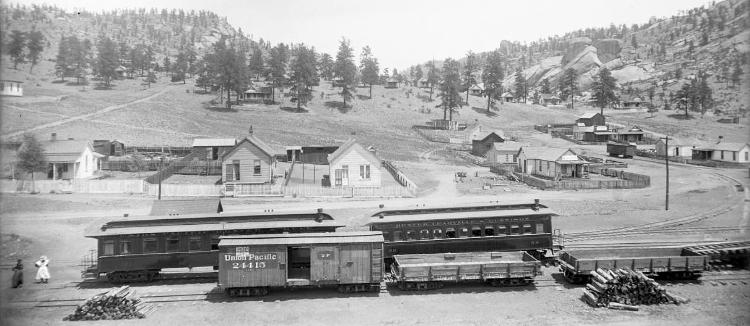
http://cdm16079.contentdm.oclc.org/cdm/singleitem/collection/p15330coll21/id/3681/rec/5
The 3 freight cars all carry UP numbers for the DL&G. The boxcar 24415 is numbered in the 24276-24470 series, listed as a 27 foot, 14 ton car, built by the UP in 1882-3. It is my most recent understanding that brake cylinders always point toward the brake staff end of DSP&P/DL&G/C&S freight cars, but this confuses me all over again:
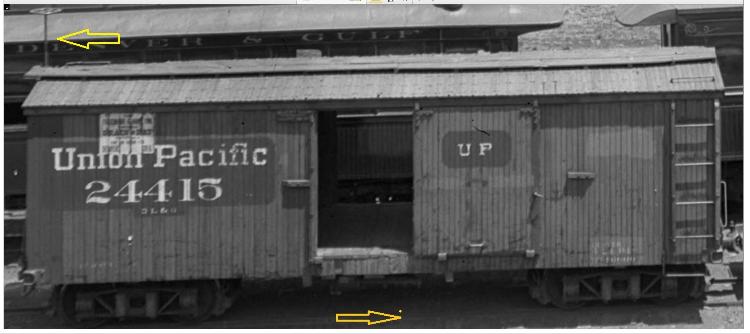
The brake cylinder points to the right end of the car, the bracing rod from the reservoir to the main brake lever (like on all C&S "phase 1" cars), is clearly visible, as is the connecting pipe from triple valve to the main train line. Yet, the brake staff is on the left end of the car! Please, someone, tell me how this worked!
The boxcar has all the features of a 27' UP built boxcar, including the cast corner irons with the rectangular poling pocket on the side of the corner and no visible truss rods (they're up next to the center sill), but the trucks are not the familiar "type B" UP swing beam trucks that Ron Rudnick describes. Instead, they look like the 14 ton trucks used on the 27' coal cars.
BTW, is that a designated "Grain and Hay" placard over the "Union Pacific" lettering? It looks painted on, not a paper sign.
The two coal cars also have a lot of disturbing surprises as well. First off, DL&G numbers 3252 and 3210 are of the series 3037-3221, which were listed as 12 ton, 26 foot Litchfield flat cars:
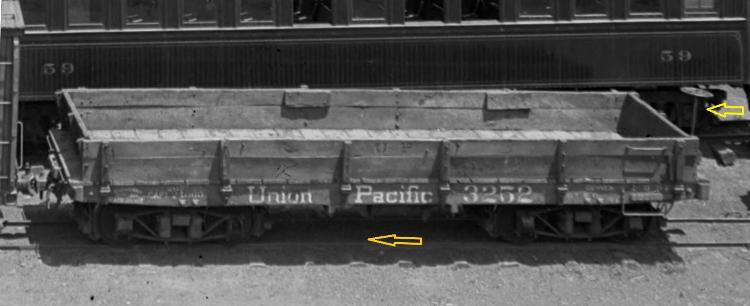
So these are flat rebuilds into low side, 2 board coal cars. The Litchfield builders mark is visible on the left end of the tapered side sill. But the car doesn't have the typical 8 stake pocket arrangement and the Litchfield plate bolster isn't visible under the sill, instead there are paired odd square bolts in the side of the sill.
And the brake cylinder is odd: Again it seems to point to the left while the brake staff is on the right end of the car. Odder still, there is no cylinder! It's just a long reservoir with triple valve on the right. Is this some sort of split reservoir/cylinder arrangement? If so, why? And why such a large reservoir, it looks to be as large as a passenger car reservoir.
Finally the trucks under this Litchfield "flat"--they look nothing like any South Park or Central truck I've ever seen. Does anyone know what these are??
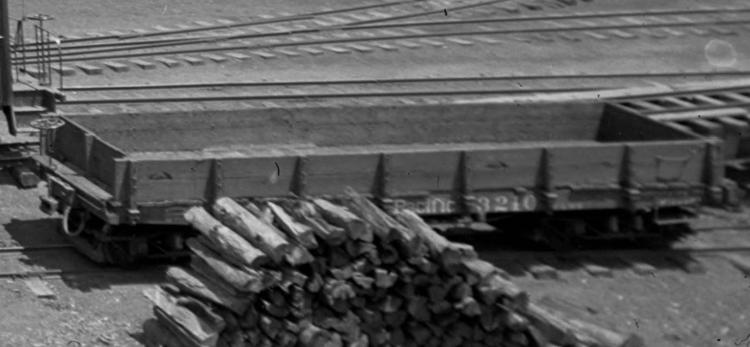
Litchfield "flat" 3210 looks much more what you'd expect: Eight stake pockets, plate bolsters under the sill, and 12 ton Litchfield trucks.
I'm in the process of building some Sn3 Cimarron Works kits for the 27' boxcar, and plan to paint and letter them like these two beauties, albeit with automatic couplers, weathered as they might appear in 1909 :
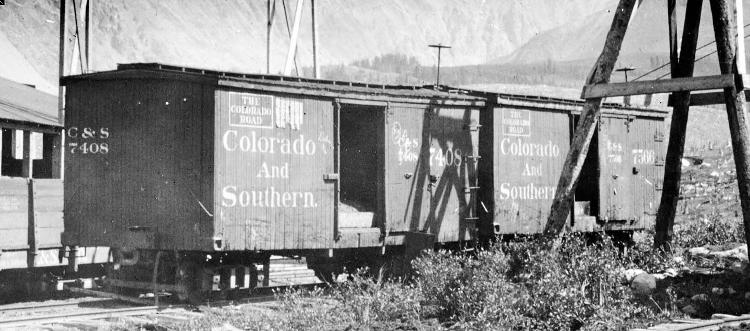
But now I don't know how to complete the underframe. Look at C&S 7408: The brake staff is at the far (right) end of the car, yet no brake cylinder/reservoir is visible between the needle beams--it must be on the other side of the car, pointed to the left, away from the brake staff. And those don't look like UP "type-B" trucks on further study. The tall transoms look a lot like the coal car type trucks, as on DL&G 24415 above.
So now I'm stuck and don't understand the brake arrangement on the inherited cars. Please, someone 'splain it to me!
URL: http://c-sng-discussion-forum.254.s1.nabble.com/Brake-staff-cylinder-confusion-and-mismatched-trucks-tp3464.html
I was studying this DPL photo of Pine in the late 1890s under maximum magnification earlier today:

http://cdm16079.contentdm.oclc.org/cdm/singleitem/collection/p15330coll21/id/3681/rec/5
The 3 freight cars all carry UP numbers for the DL&G. The boxcar 24415 is numbered in the 24276-24470 series, listed as a 27 foot, 14 ton car, built by the UP in 1882-3. It is my most recent understanding that brake cylinders always point toward the brake staff end of DSP&P/DL&G/C&S freight cars, but this confuses me all over again:

The brake cylinder points to the right end of the car, the bracing rod from the reservoir to the main brake lever (like on all C&S "phase 1" cars), is clearly visible, as is the connecting pipe from triple valve to the main train line. Yet, the brake staff is on the left end of the car! Please, someone, tell me how this worked!
The boxcar has all the features of a 27' UP built boxcar, including the cast corner irons with the rectangular poling pocket on the side of the corner and no visible truss rods (they're up next to the center sill), but the trucks are not the familiar "type B" UP swing beam trucks that Ron Rudnick describes. Instead, they look like the 14 ton trucks used on the 27' coal cars.
BTW, is that a designated "Grain and Hay" placard over the "Union Pacific" lettering? It looks painted on, not a paper sign.
The two coal cars also have a lot of disturbing surprises as well. First off, DL&G numbers 3252 and 3210 are of the series 3037-3221, which were listed as 12 ton, 26 foot Litchfield flat cars:

So these are flat rebuilds into low side, 2 board coal cars. The Litchfield builders mark is visible on the left end of the tapered side sill. But the car doesn't have the typical 8 stake pocket arrangement and the Litchfield plate bolster isn't visible under the sill, instead there are paired odd square bolts in the side of the sill.
And the brake cylinder is odd: Again it seems to point to the left while the brake staff is on the right end of the car. Odder still, there is no cylinder! It's just a long reservoir with triple valve on the right. Is this some sort of split reservoir/cylinder arrangement? If so, why? And why such a large reservoir, it looks to be as large as a passenger car reservoir.
Finally the trucks under this Litchfield "flat"--they look nothing like any South Park or Central truck I've ever seen. Does anyone know what these are??

Litchfield "flat" 3210 looks much more what you'd expect: Eight stake pockets, plate bolsters under the sill, and 12 ton Litchfield trucks.
I'm in the process of building some Sn3 Cimarron Works kits for the 27' boxcar, and plan to paint and letter them like these two beauties, albeit with automatic couplers, weathered as they might appear in 1909 :

But now I don't know how to complete the underframe. Look at C&S 7408: The brake staff is at the far (right) end of the car, yet no brake cylinder/reservoir is visible between the needle beams--it must be on the other side of the car, pointed to the left, away from the brake staff. And those don't look like UP "type-B" trucks on further study. The tall transoms look a lot like the coal car type trucks, as on DL&G 24415 above.
So now I'm stuck and don't understand the brake arrangement on the inherited cars. Please, someone 'splain it to me!
Jim Courtney
Poulsbo, WA
Poulsbo, WA
| Free forum by Nabble | Edit this page |